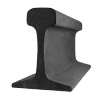Circuitron BD-2HD Current Sensing Block Occupancy Detector ~ 5522
The BD-2 and BD-2HD are current sensing train detector circuits that can be used to provide 2 color (Red/
Green) signal outputs for an isolated block of track. The BD-2 and BD-2HD can be used with common rail
wired AC or DC track power and will work with most Command Control systems (See COMMAND
CONTROL). These circuits utilize state of the art integrated circuit design for high sensitivity and reliability.
The BD-2 works by detecting the current drawn by a locomotive or lighted piece of rolling stock. Detection
can be extended to un-powered equipment by using metal wheelsets with resistors connected across the
insulator. An adjustment control is provided to set the sensitivity of the circuit and can be used to
compensate for damp conditions, outdoor use, etc. The BD-2 and BD-2HD can be powered by any 10 - 18
volt AC or DC power source, however, this source must be different than the track power (you cannot use
the accessory terminals of a power pack that is already powering the trains). Track power is routed through
the BD-2 or BD-2HD circuit board. The BD-2 has a maximum track current capacity of 3 amps, the BD-2HD
capacity is 6 amps. Both circuits can drive LED or incandescent lamp type signals directly. Maximum
output current is 250 ma. on each output for the BD-2, 500 ma. for the BD-2HD. The BD-2 will work well
for HO-Scale and smaller, the BD-2HD should be used for S Scale and larger.
CIRCUIT BOARD MOUNTING & WIRING
A section of CIRCUITRON’S PCMT can be used for simple, snap-in mounting of the circuit board(s) or you
may drill holes in the mounting pads in the corners of the board and mount the BD-2 with screws and
standoffs. Multiple circuit boards should be mounted side by side for easy power supply bussing between
boards. The BD-2 can be connected with .110" solderless connectors (available from CIRCUITRON) or by
soldering leads directly to the terminals on the printed circuit board. If soldering, use a small pencil-type
iron and electronics-grade rosin core 60/40 solder (available from Radio Shack). Use only as much heat as
necessary to obtain a good joint and do not wiggle the terminal until the solder has cooled completely.
The BD-2 and BD-2HD are current sensing train detector circuits that can be used to provide 2 color (Red/
Green) signal outputs for an isolated block of track. The BD-2 and BD-2HD can be used with common rail
wired AC or DC track power and will work with most Command Control systems (See COMMAND
CONTROL). These circuits utilize state of the art integrated circuit design for high sensitivity and reliability.
The BD-2 works by detecting the current drawn by a locomotive or lighted piece of rolling stock. Detection
can be extended to un-powered equipment by using metal wheelsets with resistors connected across the
insulator. An adjustment control is provided to set the sensitivity of the circuit and can be used to
compensate for damp conditions, outdoor use, etc. The BD-2 and BD-2HD can be powered by any 10 - 18
volt AC or DC power source, however, this source must be different than the track power (you cannot use
the accessory terminals of a power pack that is already powering the trains). Track power is routed through
the BD-2 or BD-2HD circuit board. The BD-2 has a maximum track current capacity of 3 amps, the BD-2HD
capacity is 6 amps. Both circuits can drive LED or incandescent lamp type signals directly. Maximum
output current is 250 ma. on each output for the BD-2, 500 ma. for the BD-2HD. The BD-2 will work well
for HO-Scale and smaller, the BD-2HD should be used for S Scale and larger.
CIRCUIT BOARD MOUNTING & WIRING
A section of CIRCUITRON’S PCMT can be used for simple, snap-in mounting of the circuit board(s) or you
may drill holes in the mounting pads in the corners of the board and mount the BD-2 with screws and
standoffs. Multiple circuit boards should be mounted side by side for easy power supply bussing between
boards. The BD-2 can be connected with .110" solderless connectors (available from CIRCUITRON) or by
soldering leads directly to the terminals on the printed circuit board. If soldering, use a small pencil-type
iron and electronics-grade rosin core 60/40 solder (available from Radio Shack). Use only as much heat as
necessary to obtain a good joint and do not wiggle the terminal until the solder has cooled completely.





